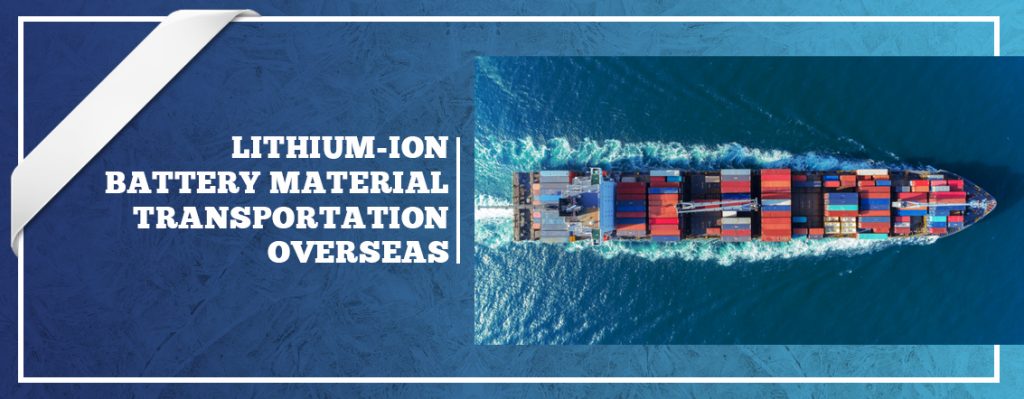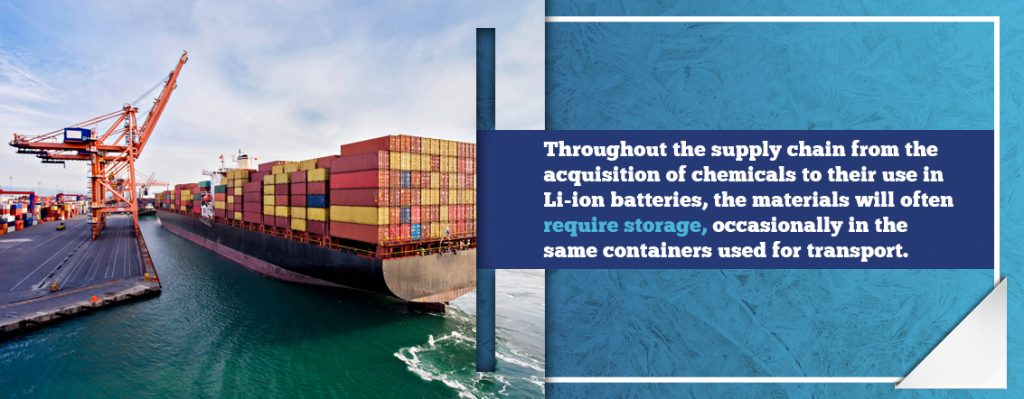
The field of transporting hazardous materials encompasses both caustic chemicals and more ordinary devices such as lithium-ion batteries. Though these batteries are standard electronics components, they still pose a danger for those nearby if the proper conditions are not followed for lithium ion battery shipping and storage containers.
Table of Contents
- What Are Lithium-Ion Batteries?
- Materials Used in Lithium-Ion Batteries
- Lithium-Ion Battery Supply Chain Storage and Handling
- Shipping and Storage Containers for Lithium-Ion Battery Materials
What Are Lithium-Ion Batteries?
Lithium-ion batteries (Li-ion) are a rechargeable form of energy storage that holds a large amount of power in a relatively small space. You may also see these referred to as secondary batteries. These batteries work by the movement of lithium ions across an electrolyte from one end to the other. Inside the device, you will find a graphite carbon anode and a cathode with a liquid electrolyte between them. The materials used in the cathode determine the various types of Li-ion batteries.
The types of materials may differ in these batteries, offering varying levels of power, energy, cost, performance and lifespan, but they all function as Li-ion power sources. Examples of these batteries include:
- Lithium cobalt oxide: This battery typically appears in mobile phones and laptops due to its low cost and moderate power delivery.
- Lithium nickel manganese cobalt oxide: Electric bikes and vehicles typically use this type of Li-ion battery.
- Lithium iron phosphate: Due to its high safety level and long life, this battery type often appears in electric motorcycles.
- Lithium manganese oxide: Though low in cost, this type of Li-ion battery also has a relatively short lifespan compared to others. It often has applications in power tools and medical devices.
- Lithium titanate: A costly battery that offers great performance, long life and a high level of safety, this type of cell often appears in smart grids and for storing solar panel energy.
- Lithium nickel cobalt aluminum oxide: With a moderate lifespan and similar performance level, this form of Li-ion battery often powers electric powertrains.
Related to these power supplies are lithium metal batteries, also known as primary batteries or non-chargeable lithium batteries. While you can ship both of these types of power sources, you must take special precautions to prevent them from shorting and catching on fire during transit.
Materials Used in Lithium-Ion Batteries
Li-ion batteries use several materials inside them as the electrolyte to transport the lithium ions between the cathode and anode. Most of these electrolytes have flammable, irritating or toxic properties, making transporting them potentially dangerous.
Some commonly-used solvents and their hazards include the following:
- 1,2 Diethoxyethane: Flammable and toxic
- 1,2 Dimethoxyethane: Flammable and toxic
- 1,3 Dioxolane: Flammable
- y-Butyrolactone: Harmful
- Diethyl carbonate: Flammable
- Dimethoxymethane: Flammable and irritating
- Dimethyl carbonate: Flammable
- Ethylene carbonate: Irritating
- Ethyl methyl carbonate: Flammable and irritating
- Propylene carbonate: Irritating
- Tetrahydrofuran: Flammable
These electrolytes may create a sweet odor when spilled. Additives in some preparations of these electrolytes could also harbor dangers from exposure.
In addition to the solvents, Li-ion batteries use lithium salts in the electrolytes. Though typically only constituting up to 5% of the battery’s weight, these salts do not ship in such small amounts. Many have corrosive properties or react with water. For example, the most commonly used lithium salt in Li-ion batteries, lithium hexafluorophosphate (LiPF6), converts to highly corrosive and toxic hydrogen fluoride (HF) when it reacts with water or moisture from the air.
Other lithium salts used in the manufacture of Li-ion batteries and their dangers include the following:
- Lithium Bis (oxalato) Borate: Irritating
- Lithium Bis (trifluoromethanesulfonyl) Imide: Corrosive and toxic
- Lithium Hexafluoroarsenate: Toxic
- Lithium Iodide: No severe hazards reported
- Lithium Perchlorate: Irritating and oxidizer
- Lithium Tetrafluoroborate: Corrosive and harmful
- Lithium Trifluoromethane Sulfonate: Irritating
- Tetraethyl-Ammonium Tetrafluoroborate: Irritating and harmful
- Triethyl-Methyl-Ammonium Tetrafluoroborate: Corrosive and harmful
To prevent harm to other transported materials and those along the supply chain, you should follow all regulations for moving these hazardous materials.
Lithium-Ion Battery Supply Chain Storage and Handling
Throughout the supply chain from the acquisition of chemicals to their use in Li-ion batteries, the materials will often require storage, occasionally in the same containers used for transport. For the highly dangerous chemicals used in Li-ion cells, the type of storage container could determine the safety of those nearby plus the integrity of the product.

For example, lithium hexafluorophosphate requires storage in a container that prevents moisture intrusion, according to the European Chemicals Agency (ECHA). The surrounding inside the container must remain cool and dry while protecting the nearby area from the leaking of the chemical. For transport by ship or plane, you must include a label indicating the corrosive nature of this material and package the chemical by UN packaging group II and class 8. The UN number for this substance is 2923 because it is a corrosive solid.
Additionally, the Globally Harmonized System of Classification and Labeling of Chemical (GHS) precautionary classification of P405 indicates you must store lithium hexafluorophosphate material locked up.
You will need extra precautions when transporting flammable solvents such as dimethoxymethane. This substance, like other combustible materials, requires storage away from any heat, spark sources or static electricity. The containers should have a ground connection to keep their contents from igniting.
When exposed to air, the vapors produced from this solvent may also be flammable. You must keep this chemical and others like it tightly closed in a cool, dry place to prevent the formation of such hazardous vapors and never use compressed air to transfer or stir the chemical.
For handling similar lithium salts and solvents for the electrolytes, take similar precautions during storage and transport based on the chemicals’ hazards.
Shipping and Storage Containers for Lithium-Ion Battery Materials
Whether you need lithium cobalt oxide transport containers or those for carrying the solvents used in these types of batteries, you must consider the dangers posed of making the wrong choice.
For example, if you need to transport highly flammable solvents such as diethyl carbonate, dimethoxymethane or dimethyl carbonate, consider an explosion-proof refrigerated container. The refrigeration unit protects the chemicals from heat, while the container’s exterior keeps the products inside safe from external damage caused by hazardous environments. These refrigerated containers, also called reefer units, keep extreme heat from igniting chemicals inside. One type uses a 7kW refrigeration unit to keep temperatures down to 0 degrees Celsius (32 degrees Fahrenheit) when the outside temperature reaches 30 degrees Celsius (86 degrees Fahrenheit).
Explosion-proof containers come in a variety of designs based on the hazards of the environment you keep them in. The ATEX directive governs the type of protection needed when transporting goods through a variety of potentially explosive settings. This directive places equipment into one of two groups.
- Group I: Equipment used for mining or underground fire or explosion hazard
- Group II: Equipment used in all other environments where explosions could occur
Group II is the most commonly encountered one for transportation and storage, and equipment in this group falls into one of three categories based on the likelihood of an explosion. Category 1 encompasses environments where explosions are highly likely. Category 2 includes those places where such events may happen, while Category 3 is for locations where explosions rarely occur. If you need an explosion-proof reefer for storing or transporting your flammable battery chemicals, you need to know the kind of environment and its explosion hazard when choosing your container to ensure that your chemicals get the protection they need.
Talk to a Specialist in Hazardous Materials Transportation

You can learn about container options that will protect your lithium battery materials from damage during transport by maintaining a safe temperature. In preserving the raw materials for the process, our transport and storage containers facilitate the production of lithium-ion batteries. Make us part of your battery supply chain. Contact one of our specialists today at Klinge Corporation to get started.
